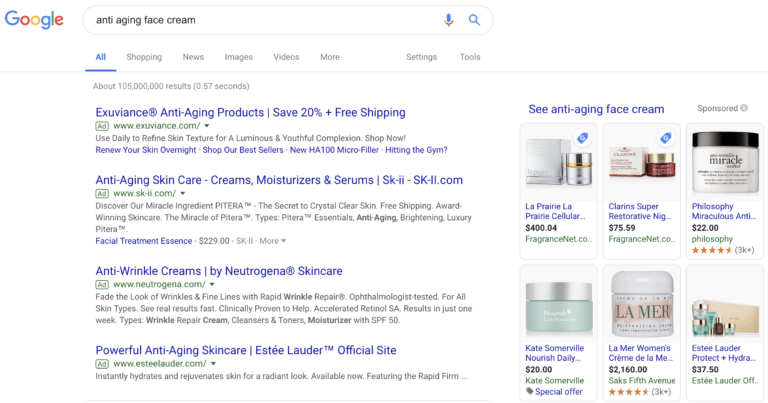Often, smaller companies struggle to compete in competitive markets where megabrands dominate.
When cost per clicks are sky high in Google Ads and competition is tough, it can be hard to elbow your way in.
But while it may be difficult, that doesn’t mean it’s impossible.
Sometimes, you just have to approach things more creatively.
In this article, I’ll share with you some of the strategies we’re seeing smaller companies use to get a leg up in markets that are dominated by larger players.
1. Focus & Narrow Your Efforts
One of our clients is a signage company that caters to Hollywood-type customers. Their signs are often used during movie premiers and similar events.
If you’ve ever attended one of these events (or seen photos of them), you’ve probably seen their banners, backdrops, and displays.
Competition within this space is fierce and budgets are huge.
Our client spends at least $30,000 on Google each month for online advertising. This isn’t small potatoes!
But even so, they’re highly outspent by some of the larger competitors in this space. We’ve asked for more budget to keep up, but the client has been reluctant.
We’ve had this client for about seven years. The bulk of their advertising budget has been spent on Google Shopping campaigns, branded terms on the search network, and remarketing most of that time.
But over the past couple of years, our ROI has been slowly decreasing. We know we have to change our strategy, but with no additional budget, our options are limited.
This year, we tested just about every approach we could think of to bring our ROI back up.
We tried in-market audiences on search ads, customer match, demographic adjustments and more.
But nothing wowed us.
So in 2019, we’re going to try a new approach.
Rather than spread the budget more thinly over different geographical markets, we’re going to focus our efforts.
We’re going to narrow in on the top three geographic markets (Los Angeles, New York, and probably Chicago) and put the bulk of our efforts (and dollars) there.
Before, we served ads to smaller geographic markets in addition to the big three. We saw positive ROI in these markets, but many of the sales were one-offs as opposed to repeat business.
By eliminating our spend in those smaller markets, we’ll have more budget to build the client’s brand in areas where film and television events happen more regularly.
The idea behind this strategy is that you can’t always compete with mega brands across the board.
In those cases, choose just one slice in which to compete — and then put all of your budget behind it.
2. Forget the Sale – Send a Sample
Not long ago, we spoke with a prospective client that’s in the cosmetics space. They have a wrinkle-reducing face cream that sounds amazing, but they’re struggling to get traction in the market.
And no wonder! Cosmetics is hugely competitive — especially when it comes to anti-aging creams.
Open the pages of any magazine or walk your local mall and you’ll see that the market is dominated by larger players.
That same market dominance is evident in paid search. Try Googling “anti aging face cream” and see what comes up:

Trying to get a piece of this ad real estate will be tough!
Not surprisingly, our prospective client had become frustrated with his in-house PPC efforts. So he decided to change tactics.
Now, he’s creating PPC ads and sending traffic to his blog where he’s offering free samples.
The more I thought about it, the more I thought he was onto something.
Instead of sending non-branded PPC traffic to your ecommerce product pages, why not send traffic to a landing page and use this page to describe the product and offer a free sample.
When someone requests a free sample, you could use it as an opportunity to continue the conversation via email marketing and remarketing.
You could also include a coupon code with the free sample to purchase a full-size sample or a special offer for complementary products.
Anytime you offer to give something away for free, you open the door to potential abuse. But if things get out of hand, you could start charging a token fee or take other steps to tighten your offer.
Not every product will be suitable for sampling. But I could totally see this working with some types of products, such as non-perishable food items.
And it might be an innovative, out-of-the-box way to get the attention of your audience.
3. Leverage Your Google Ads Advertising with Other Marketing
Sometimes when smaller businesses complain about not being able to compete with megabrands, they’re not considering the full picture.
They open their Google Ads account, count up what they’re getting in conversions, look at what they’re spending, and conclude that it’s a losing proposition.
And so they prematurely shut down their PPC efforts.
But you can’t make decisions about ROI at the account level.
You need to think more broadly. And specifically, you have to think about how you can use other marketing strategies to further leverage your Google Ads spend. After all, PPC shouldn’t exist in a vacuum.
Here’s an example: We worked with a florist that was paying about $80 CPA. His average sale was also about $80.
At the account level, this doesn’t look promising.
But viewed within the context of all their marketing activities, this was actually a great deal!
Here’s how it worked:
The client was finding most of its new customers through paid search advertising. The initial sale acted (almost) as a loss leader.
After the sale, customer data was uploaded into the company’s CRM — including the occasion for which the flowers were purchased.
On the anniversary of that special occasion, our client would remarket to the client via email. In many cases, the client would make another purchase.
Our client looks good to the customer (“My florist reminded me about my parent’s wedding anniversary!” ) and the customer looks good to the recipient of the purchase (“Our son remembered our wedding anniversary!”).
Before long, one-time customers become loyal customers.
The lesson here?
If you can leverage your PPC leads with other marketing strategies, your ROI may go well beyond what happens in your Google Ads account.
What Creative Strategies Are You Willing to Try?
It’s true that competing with megabrands in paid search advertising can be challenging.
But don’t give up too easily!
By narrowing your efforts, trying unconventional approaches, and leveraging other marketing strategies, you might just come up with a winning strategy that’s all your own.
For more on how to compete against megabrands, take a look at my earlier Search Engine Journal post on the topic.
More Resources:
- 10 Tips on How to Compete When CPCs Are Super High
- 4 Tactics to Compete with Huge SEM Advertisers
- PPC 101: A Complete Guide to Pay-Per-Click Marketing Basics
Image Credits
Featured Image: Dreamstime.com
Screenshots taken by author, January 2019





